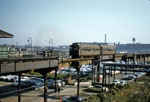|
|
|
|
.
|
|
|
|
.
Armour
(4300S/1200W)
Racine Avenue and 43rd
Street, Union Stock Yards (New City)
Service Notes:
Stock Yards Line
Quick Facts:
Address: TBD
Established: April 8, 1908
Original Line: South Side Elevated Railroad, Stock Yards branch
Previous Names: none
Skip-Stop Type: n/a
Rebuilt: n/a
Status: Demolished
History:
Many of the stations on the Stock Yards branch -- and three of the four in the yard itself -- were named not for streets but for the meat packing companies whose plants they were near and served. Armour was no exception, serving its namesake firm Armour and Company, whose cattle often grazed below the platforms.
Since trains operated in a one-way loop around the yards, all that was required at each station was one side platform. Armour's wood-decked side platform was covered by a peaked-roof canopy of steel supports down the middle of the platform with a gently-curved bracket and intricate latticework supporting a hipped corrugated metal roof. This was usually supplemented by a small, simple station house, as was the case at Armour.
By the mid-1950s, it was becoming apparent that falling ridership and increasing deterioration of the Stock Yards line and its cousin, the Kenwood line, would require some sort of immediate action. Plans were formulated for how to continue service, but no agreement could be reached with the lessor Chicago Junction Railway (from whom CTA rented some of the property on which the Stock Yards and Kenwood lines were located). Other factors also sealed the Stock Yards branch's fate: Due to changes in the meat packing industry, the Union Stock Yards became redundant and outdated. Now with its main purpose waning, the Stock Yards branch, and Armour station, closed October 7, 1957 and was demolished thereafter.
|
|
This Chicago-L.org article is a stub. It will be expanded in the future as resources allow. |
 |
cta2918.jpg (193k) Car 2917 makes up half of this two-car train of wooden ex-Met "L" cars near Armour station on the Stock Yards branch on September 30, 1957. The last wood cars operated on the system were ex-Metropolitan Elevated cars; the SY would close a week after this photo was taken and the Kenwood branch followed a few months later. The cars of the 2858-2927 group, built by Pullman for the Met in 1906-07, featured a steel underframe to prevent the wooden car body from sagging; many Met car series had this feature. This steel underframe insured a long life, and were part of the reason these cars lasted to the end of wood-car service. (Photo by George Krambles, courtesy of the Krambles-Peterson Archive) |
|